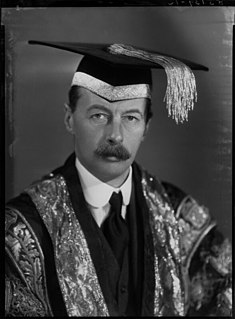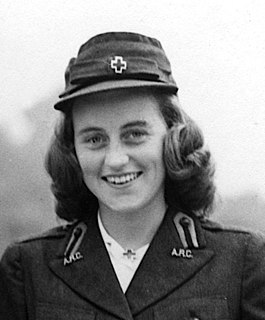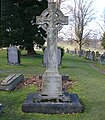
Chatsworth House is a stately home in the Derbyshire Dales, 3.5 miles (5.6 km) north-east of Bakewell and 9 miles (14 km) west of Chesterfield, England. The seat of the Duke of Devonshire, it has belonged to the Cavendish family since 1549. It stands on the east bank of the River Derwent, across from hills between the Derwent and Wye valleys, amid parkland backed by wooded hills that rise to heather moorland. The house holds major collections of paintings, furniture, Old Master drawings, neoclassical sculptures and books. Chosen several times as Britain's favourite country house, it is a Grade I listed property from the 18th century, altered in the 19th. In 2011–2012 it underwent a £14-million restoration. The owner is the Chatsworth House Trust, an independent charitable foundation, on behalf of the Cavendish family.

Duke of Devonshire is a title in the Peerage of England held by members of the Cavendish family. This branch of the Cavendish family has been one of the wealthiest British aristocratic families since the 16th century and has been rivalled in political influence perhaps only by the Marquesses of Salisbury and the Earls of Derby.

Deborah Vivien Cavendish, Duchess of Devonshire, was an English aristocrat, writer, memoirist, and socialite. She was the youngest and last-surviving of the six Mitford sisters, who were prominent members of British society in the 1930s and 1940s.

Sir Joseph Paxton was an English gardener, architect, engineer and Member of Parliament, best known for designing the Crystal Palace and for cultivating the Cavendish banana, the most consumed banana in the Western world.

Lord Frederick Charles Cavendish was an English Liberal politician and protégé of the Prime Minister, William Ewart Gladstone. Cavendish was appointed Chief Secretary for Ireland in May 1882 but was murdered only hours after his arrival in Dublin, a victim of the politically motivated Phoenix Park killings.

William Cavendish, 3rd Duke of Devonshire, was a British nobleman and Whig politician who sat in the House of Commons from 1721 to 1729 when he inherited the Dukedom.

William George Spencer Cavendish, 6th Duke of Devonshire,, styled Marquess of Hartington until 1811, was a British peer, courtier, nobleman, and Whig politician. Known as the "Bachelor Duke", he was Lord Chamberlain of the Household between 1827 and 1828 and again between 1830 and 1834. The Cavendish banana is named after him.

Spencer Compton Cavendish, 8th Duke of Devonshire,, styled Lord Cavendish of Keighley between 1834 and 1858 and Marquess of Hartington between 1858 and 1891, was a British statesman. He has the distinction of having held leading positions in three political parties: leading the Liberal Party, the Liberal Unionist Party and the Conservative Party in either the House of Commons or the House of Lords. After 1886 he increasingly voted with the Conservatives. He declined to become prime minister on three occasions, because the circumstances were never right. Historian and politician Roy Jenkins said he was "too easy-going and too little of a party man." He held some passions, but he rarely displayed them regarding the most controversial issues of the day.

Edward William Spencer Cavendish, 10th Duke of Devonshire,, known as the Marquess of Hartington from 1908 to 1938, was a British politician. He was the head of the Devonshire branch of the House of Cavendish. He had careers with the army and in politics and was a senior freemason. His sudden death, apparently of a heart attack at the age of fifty-five, occurred in the presence of the suspected serial killer John Bodkin Adams.

Andrew Robert Buxton Cavendish, 11th Duke of Devonshire,, styled Lord Andrew Cavendish until 1944 and Marquess of Hartington from 1944 to 1950, was a British Conservative and later Social Democratic Party politician. He was a minister in the government of Prime Minister Harold Macmillan, but is best known for opening Chatsworth House to the public. His sister-in-law was Kathleen Kennedy, sister of U. S. President John F. Kennedy and U. S. Senators Robert F. Kennedy and Ted Kennedy.

William John Robert Cavendish, Marquess of Hartington was a British politician and British Army officer. He was the elder son of Edward Cavendish, 10th Duke of Devonshire, and therefore the heir to the dukedom. He was killed in action in the Second World War during fighting in the Low Countries in September 1944 whilst leading a company of the Coldstream Guards.
Peregrine Andrew Morny Cavendish, 12th Duke of Devonshire, is an English peer. He is the only surviving son of Andrew Cavendish, 11th Duke of Devonshire and his wife, the former Deborah Mitford. He succeeded to the dukedom following the death of his father on 3 May 2004. Before his succession, he was styled Marquess of Hartington. His immediate family are owner-occupiers of Chatsworth House and are worth an estimated £800 million. Estates landscaped before 1900 by the family are parts of Derbyshire and North Yorkshire. Other capital managed by the Duke includes fine and contemporary art, forestry and farming.

Kathleen Agnes Cavendish, Marchioness of Hartington, also known as "Kick" Kennedy, was an American socialite. She was the second daughter of Joseph P. Kennedy Sr. and Rose Kennedy as well as a sister of former U.S. President John F. Kennedy and Senators Robert F. Kennedy and Edward M. "Ted" Kennedy and the wife of the Marquess of Hartington, heir apparent to the 10th Duke of Devonshire.

Hardwick Hall in Derbyshire is an architecturally significant country house from the Elizabethan era, a leading example of the Elizabethan prodigy house. Built between 1590 and 1597 for Bess of Hardwick, it was designed by the architect Robert Smythson, an exponent of the Renaissance style. Hardwick Hall is one of the earliest examples of the English interpretation of this style, which came into fashion having slowly spread from Florence. Its arrival in Britain coincided with the period when it was no longer necessary or legal to fortify a domestic dwelling.

Mary Alice Cavendish, Duchess of Devonshire, was a British courtier who served as Mistress of the Robes to Queen Elizabeth II from 1953 to 1967. She was the granddaughter of Prime Minister Robert Gascoyne-Cecil, 3rd Marquess of Salisbury.

William Cavendish, 1st Earl of Devonshire was an English nobleman, politician, and courtier.

Edensor is a village and civil parish in Derbyshire, England. The population of the civil parish as of the 2011 census was 145.

Beeley is a village and civil parish in northern Derbyshire, England. Located near Bakewell in the Derbyshire Dales, it is situated on the B6012 road, between Rowsley and Edensor. The civil parish population at the 2011 Census was 195.

The Cavendishfamily is a British noble family, of Anglo-Norman origins. They rose to their highest prominence as Duke of Devonshire and Duke of Newcastle.
Edensor is a civil parish in the Derbyshire Dales district of Derbyshire, England. The parish contains 50 listed buildings that are recorded in the National Heritage List for England. Of these, one is listed at Grade I, the highest of the three grades, six are at Grade II*, the middle grade, and the others are at Grade II, the lowest grade. The parish contains the model village of Edensor, which was created by Joseph Paxton for the 6th Duke of Devonshire, and the surrounding area. Most of the listed buildings are houses, cottages and associated structures, mainly within the village. The other listed buildings include a church, a cross and a tomb in the churchyard, a guidestone, a bridge, a former cotton mill, a hotel and a stable block converted for other uses, an ornamental fountain, a water trough, the wall and railings enclosing the village, and a telephone kiosk.





































